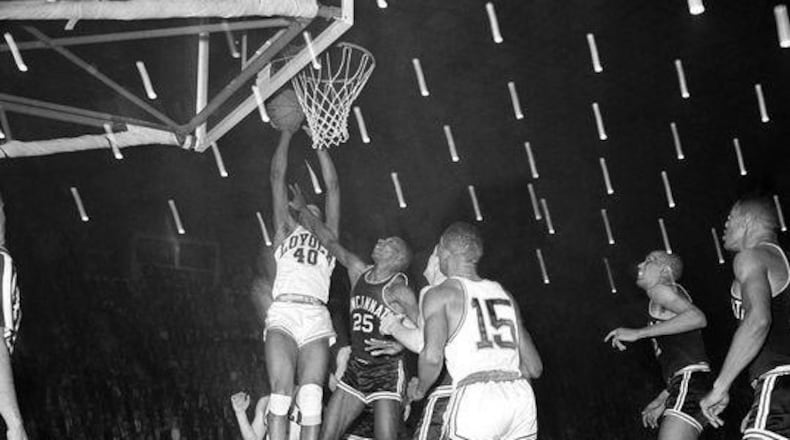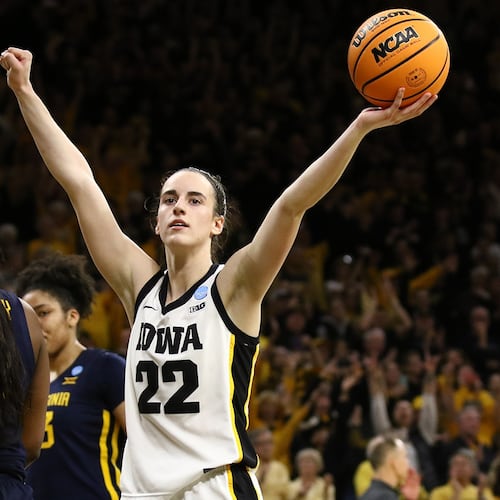There won’t be a Final Four this year — Atlanta’s loss after the NCAA Tournament was canceled due to the coronavirus pandemic. However, The Atlanta Journal-Constitution’s Mark Bradley, a 2015 inductee of the U.S. Basketball Writers Association Hall of Fame, will present his list of the Top 10 Final Fours of all-time. The list will be presented in reverse order, culminating with the greatest men’s basketball championship.
Today: No. 4 — 1963
Before UCLA got around to winning seven in a row, the closest any school came to three consecutive NCAA titles was Cincinnati. The Bearcats beat Ohio State – with Jerry Lucas, John Havlicek and Bobby Knight – in the 1961 and 1962 finals. Those came just after the program had bid adieu to Oscar Robertson, then regarded as the best player in collegiate annals. They were coached by Ed Jucker, who’d replaced his mentor George Smith in 1960. Prior to that, Jucker was known mostly as the guy who’d helped Sandy Koufax land a UC basketball scholarship.
The Bearcats were an odd program. They were bordered by Kentucky and Adolph Rupp to the south, by Louisville and Peck Hickman to the southwest and by Ohio State to the north. They’d never reached the NCAA tournament before the Big O; they made the Final Four twice with him, losing in the semifinals to California both times. They weren’t ranked in the Associated Press top 10 – that’s as high as the poll went then – until February of their first championship season; they spent the entirety of the next year ranked below Ohio State, which they beat again come March.
By the 1962-63 season, the message had gotten through. Cincinnati started No. 1 and stayed there, even after its one loss, which came in February by one point at Wichita State. The Bearcats beat Oregon State 80-64 in the semifinal. The Final Four, which wasn’t yet known as such, was being held in Louisville’s Freedom Hall, 106 miles from the UC campus. The whole thing felt like a coronation.
Cincinnati’s opponent in the final was Loyola-Chicago, which was 29-2 and had also lost by a point to Wichita. The Ramblers routed Duke and Art Heyman 94-75 in their semifinal. That score was no aberration. At coach George Ireland’s insistence, they played faster than any team in the land. They broke 100 points 11 times that season. Their average 93.9 points was tops in the nation.
Ireland had become fixated on Cincinnati. Sports Illustrated reported that he or his assistant scouted the Bearcats 10 times. You wouldn’t have known it from how the title game began. Working at Jucker’s preferred ponderous pace – he’d written a book entitled, “Cincinnati Power Basketball” – the Bearcats led 29-21 at the half. (Loyola had made one of its first 14 shots.) With 13:56 left, it was 45-30. They began stalling, but they missed enough free throws and made so many turnovers – 16, a ton by Cincy standards – that Loyola clambered back.
The Cincy lead was three points inside the final 30 seconds of regulation. Guard Tony Yates had a layup to make it five. Vic Rouse blocked it, and Les (Big Game) Hunter tipped home a Jerry Harkness miss at the other end.
Larry Shingleton was fouled with 12 seconds remaining. He made the first to make it a two-point game. He missed the second. Ron Miller pushed the ball upcourt – Cincinnati fans insist he traveled – and found Harkness on the left wing. His jumper over Tom Thacker tied it. Five seconds remained, but the Bearcats were so flummoxed they couldn’t bring themselves to call timeout.
Overtime wound down with the game tied and runnin’ Ramblers holding the ball. The long possession was interrupted by a jump ball, but Johnny Egan, 5-foot-10, controlled the tip against Shingleton, also 5-10. Radio broadcaster Red Rush told his Chicago audience: “Cincinnati, the team that always holds the ball – they’re seeing what it feels like.” Then: “I guarantee you one thing. They’ll give the ball to Harkness when it’s time.”
Sure enough, Harkness moved again into the left corner and rose, but this time he passed to Hunter, who fully expected Harkness to shoot, at the top of the lane. Hunter’s shot bounced off the rim, off the backboard and …
Into the hands of center Vic Rouse, who laid it in.
This was Rush: “It’s over! We won! We won! We won! We won the ballgame! We won the ballgame! Loyola won the ballgame! OHHHH!!!! We won – 60 to 58!”
It was the first NCAA championship decided on a buzzer basket. There have since been two more – Lorenzo Charles’ dunk in 1983 and Kris Jenkins’ 3-pointer in 2016.
Credit: Zbigniew Bzdak
Credit: Zbigniew Bzdak
Loyola was also the second national champ with four African-American starters. (Cincinnati in 1962 had been the first.) This became a major issue before the Ramblers’ first tournament game. Mississippi State, the SEC champ, had to defy its legislature by sneaking across the state line to fly to East Lansing, Mich., for the Mideast Regional. Before tip-off, Loyola captain Harkness shook hands with Maroons captain Joe Dan Gold in the center circle. Photographs of that moment ran in newspapers coast-to-coast. The Loyola-Mississippi State meeting has become known as “The Game of Change.”
Gold died in 2011. Harkness attended his funeral in West Liberty, Ky. As Mike Lopresti of USA Today reported, a photo of the Harkness-Gold handshake was on the casket.
THE SERIES
No. 10: 1979
No. 9: 1991
No. 8: 1968
No. 7: 1982
No. 6: 1985
No. 5: 1974
No. 4: 1963
-♦-
About the Author
The Latest
Featured



